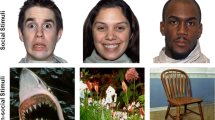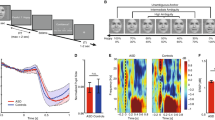Abstract
Respiratory Sinus Arrhythmia (RSA), heart rate, and accuracy and latency of emotion recognition were evaluated in children with autism spectrum disorders (ASD) and typically developing children while viewing videos of faces slowly transitioning from a neutral expression to one of six basic emotions (e.g., anger, disgust, fear, happiness, sadness, and surprise). Children with ASD were slower in emotion recognition and selectively made more errors in detecting anger. ASD children had lower amplitude RSA and faster heart rate. Within the ASD group, children with higher amplitude RSA recognized emotions faster. Less severe ASD symptoms and increased gaze to the eye region in children with ASD were related to more accurate emotion recognition.





Similar content being viewed by others
Notes
In the ASD group, 8 children did not meet the diagnostic criteria on the ADOS, 3 children were unable to understand the instructions to complete the experimental task, 4 children did not meet IQ criteria of 75 or above, and 1 child’s data were lost due to equipment malfunctioning during data collection. In the control group, 4 children scored above the clinical cut-off on the CBCL, 1 child had a diagnosis of a learning disability, 1 child did not meet IQ criteria of 75 or above, 1 child slept during data collection, and 2 children's data were lost due to equipment malfunctioning.
In the control group, the only significant difference between the males and females was the latency to recognize anger, with males recognizing faster than females, F(1, 35) = 8.85, p = .005. No other significant differences were found on the speed and accuracy of emotion recognition, RSA, eye gaze, and SRS subscales.
Modifications included a series of steps: (1) Final frames of the image sequences that included similar action units for six basic emotions (sadness, anger, fear, disgust, happiness, and surprise) were chosen, (2) Image sequences that included approximately the same number of frames were chosen, (3) Image sequences in which persons’ expressions were ambiguous were eliminated, (4) The final database was evaluated to include an equal number of males and females as much as possible, and (5) Each of the frames in image sequences was morphed so that there were 8 new frames between each of the originals.
Because the distribution of errors was skewed for happiness, surprise, and sadness, non-parametric analyses were also performed for each emotion to evaluate the group differences using Mann–Whitney U tests. Confirming the parametric tests, the ASD group made significantly more errors than the control group only to anger, z = −2.22, p = .026.
The expression of happiness was excluded from the analyses because there was only 1 error across all trials.
References
Achenbach, T. M., & Rescorla, L. A. (2000). Manual for the ASEBA preschool forms and profiles. Burlington, VT: University of Vermont, Research Center for Children, Youth and Families.
Adolphs, R., Sears, L., & Piven, J. (2001). Abnormal processing of social information from faces in autism. Journal of Cognitive Neuroscience, 13, 232–240.
American Psychiatric Association. (1994). Diagnostic and statistical manual of mental disorders (4th ed.). Washington, DC: American Psychiatric Association.
Back, E., Ropar, D., & Mitchell, P. (2007). Do the eyes have it? Inferring mental states from animated faces in autism. Child Development, 78, 397–411.
Bar-Haim, Y., Shulman, C., Lamy, D., & Reuveni, A. (2006). Attention to eyes and mouth in high-functioning children with autism. Journal of Autism and Developmental Disorders, 36, 131–137.
Baron-Cohen, S., Spitz, A., & Cross, P. (1993). Do children with autism recognize surprise? A research note. Cognition and Emotion, 7, 507–516.
Bazhenova, O. V., Plonskaia, O., & Porges, S. W. (2001). Vagal reactivity and affective adjustment in infants during interaction challenges. Child Development, 72, 1314–1326.
Begeer, S., Koot, H. M., Rieffe, C., Terwogt, M. M., & Stegge, H. (2008). Emotional competence in children with autism: Diagnostic criteria and empirical evidence. Developmental Review, 28, 342–369.
Blair, R. J. R. (1999). Psychophysiological responsiveness to the distress of others in children with autism. Personality and Individual Differences, 26, 477–485.
Blair, R. J. R. (2003). Facial expressions, their communicatory functions, and neuro-cognitive substrates. Philosophical Transactions of the Royal Society of London Series B, 358, 561–572.
Blair, R. J. R., & Coles, M. (2000). Expression recognition and behavioral problems in early adolescence. Cognitive Development, 15, 421–434.
Capps, L., Yirmiya, N., & Sigman, M. (1992). Understanding of simple and complex emotions in non-retarded children with autism. Journal of Child Psychology and Psychiatry and Allied Disciplines, 33, 1169–1182.
Castelli, F. (2005). Understanding emotions from standardized facial expressions in autism and normal development. Autism, 9, 428–449.
Celani, G., Battacchi, M. W., & Arcidiacono, L. (1999). The understanding of the emotional meaning of facial expressions in people with autism. Journal of Autism and Developmental Disorders, 29, 57–66.
Cohn, J. F., Zlochower, A. J., Lien, J., & Kanade, T. (1999). Automated face analysis by feature point tracking has high concurrent validity with manual FACS coding. Psychophysiology, 36, 35–43.
Constantino, J. N. (2002). Social responsiveness scale. Los Angeles: Western Psychological Services.
Constantino, J. N., Davis, S. A., Todd, R. D., Schindler, M. K., Gross, M. M., Brophy, S. L., et al. (2003). Validation of a brief quantitative measure of autistic traits: Comparison of the social responsiveness scale with the autism diagnostic interview-revised. Journal of Autism and Developmental Disorders, 33, 427–433.
Corona, R., Dissanayake, C., Arbelle, S., Wellington, P., & Sigman, M. (1998). Is affect aversive to young children with autism? Behavioral and cardiac responses to experimenter distress. Child Development, 69, 1494–1502.
Dalton, K. M., Nacewicz, B. M., Johnstone, T., Schaefer, H. S., Gernsbacher, M. A., Goldsmith, H. H., et al. (2005). Gaze fixation and the neural circuitry of face processing in autism. Nature Neuroscience, 8, 519–526.
Denver, J. W. (2004). The social engagement system: Functional differences in individuals with autism (Doctoral dissertation, University of Maryland, 2004). Dissertation Abstracts International, DAI-B 65/03, 1591.
Denver, J. W., Reed, S. F., & Porges, S. W. (2007). Methodological issues in the quantification of respiratory sinus arrhythmia. Biological Psychology, 74, 286–294.
Dimberg, U., & Petterson, M. (2000). Facial reactions to happy and angry facial expressions: Evidence for right hemisphere dominance. Psychophysiology, 37, 693–696.
Golan, O., Baron-Cohen, S., & Golan, Y. (2008). The “reading the mind in films” task (child version): Complex emotion and mental state recognition in children with and without autism spectrum conditions. Journal of Autism and Developmental Disorders, 38, 1534–1541.
Guyer, A. E., McClure, E. B., Adler, A. D., Brotman, M. A., Rich, B. A., Kimes, A. S., et al. (2007). Specificity of facial expression labeling deficits in childhood psychopathology. Journal of Child Psychology and Psychiatry, 48, 863–871.
Hirstein, W., Iversen, P., & Ramachandran, V. S. (2001). Autonomic responses of autistic children to people and objects. Proceedings of the Royal Society of London Series B, 268, 1883–1888.
Hobson, R. P. (1986a). The autistic child’s appraisal of expressions of emotion. Journal of Child Psychology and Psychiatry, 27, 321–342.
Hobson, R. P. (1986b). The autistic child’s appraisal of expressions of emotion: A further study. Journal of Child Psychology and Psychiatry, 27, 671–680.
Hobson, R. P., Ouston, J., & Lee, A. (1989). Recognition of emotion by mentally retarded adolescents and young adults. American Journal of Mental Retardation, 93, 434–443.
Howard, M. A., Cowell, P. E., Boucher, J., Broks, P., Mayes, A., Farrant, A., et al. (2000). Convergent neuroanatomical and behavior evidence of an amygdala hypothesis of autism. NeuroReport, 11, 2931–2935.
Humphreys, G. W., Donnelly, N., & Riddoch, M. J. (1993). Expression is computed separately from facial identity, and it is computed separately for moving and static faces: Neuropsychological evidence. Neuropsychologia, 31, 173–181.
Izard, C., Fine, S., Schultz, D., Mostow, A., Ackerman, B., & Youngstrom, E. (2001). Emotion knowledge as a predictor of social behavior and academic competence in children at risk. Psychological Science, 12, 18–23.
Kaufman, A. S., & Kaufman, N. L. (1990). Kaufman brief intelligence test: Manual. Circle Pines, MN: American Guidance Service.
Klin, A., Jones, W., Schultz, R., Volkmar, F., & Cohen, D. (2002). Visual fixation patterns during viewing of naturalistic social situations as predictors of social competence in individuals with autism. Archives of General Psychiatry, 59, 809–816.
Kuusikko, S., Pollock-Wurman, R., Jussila, K., Carter, A. S., Mattila, M. L., Ebeling, H., et al. (2008). Social anxiety in high-functioning children and adolescents with autism and asperger syndrome. Journal of Autism and Developmental Disorders, 38, 1697–1709.
Langdell, T. (1982). Peer perception: Toward a unified theory of autism. In D. Park (Ed.), Proceedings of the 1981 International Conference on Autism, Boston, USA (pp. 89–96). Washington, D.C: National Society for Children and Adults with Autism.
Lord, C., Risi, S., Lambrecht, L., Cook, E. H., Leventhal, B. L., DiLavore, P. C., et al. (2000). The autism diagnostic observation schedule-generic: A standard measure of social and communication deficits associated with the spectrum of autism. Journal of Autism and Developmental Disorders, 30, 205–223.
Lord, C., Rutter, M., & Le Couteur, A. (1994). Autism diagnostic interview-revised: A revised version of a diagnostic interview for caregivers of individuals with possible pervasive developmental disorders. Journal of Autism and Pervasive Developmental Disorders, 24, 659–685.
Loveland, K. A., Tunali-Kotoski, B., Chen, Y. R., Ortegon, J., Pearson, D. A., Brelsford, K. A., et al. (1997). Emotion recognition in autism: Verbal and nonverbal information. Development and Psychopathology, 9, 579–593.
MacNeil, B. M., Lopes, V. A., & Minnes, P. M. (2009). Anxiety in children and adolescents with autism spectrum disorders. Research in Autism Spectrum Disorders, 3, 1–21.
Mazefsky, C. A., & Oswald, D. P. (2008). Emotion perception in Asperger’s syndrome and high-functioning autism: The importance of diagnostic criteria and cue intensity. Journal of Autism and Developmental Disorders, 37, 1086–1095.
Ming, X., Julu, P. O. O., Brimacombe, M., Connor, S., & Daniels, M. L. (2005). Reduced parasympathetic activity in children with autism. Brain and Development, 27, 509–516.
Morrison, R. L., & Bellack, A. S. (1981). The role of social perception in social skills. Behavior Therapy, 12, 69–79.
Mostow, A. J., Izard, C. E., Fine, S., & Trentacosta, C. J. (2002). Modeling emotional, cognitive, and behavioral predictors of peer acceptance. Child Development, 73, 1775–1787.
Owley, T., Leventhal, B. L., & Cook, E. H. (2005). The autistic spectrum disorders. In W. M. Klykylo & J. Kay (Eds.), Clinical child psychiatry (pp. 371–389). West Sussex, UK: Wiley.
Ozonoff, S., Pennington, B. F., & Rogers, S. J. (1990). Are there emotion perception deficits in young autistic children? Journal of Child Psychology and Psychiatry and Allied Disciplines, 31, 343–361.
Pelphrey, K. A., Morris, J. P., McCarthy, G., & Labar, K. S. (2007). Perception of dynamic changes in facial affect and identity in autism. Social Cognitive and Affective Neuroscience, 2, 140–149.
Pelphrey, K. A., Sasson, N. J., Reznick, S. J., Paul, G., Goldman, B. D., & Piven, J. (2002). Visual scanning of faces in autism. Journal of Autism and Developmental Disorders, 32, 249–261.
Pichon, S., de Gelder, B., & Grèzes, J. (2009). Two different faces of threat: Comparing the neural systems for recognizing fear and anger in dynamic body expressions. NeuroImage, 47(4), 1873–1883.
Porges, S.W. (1985). Method and apparatus for evaluating rhythmic oscillations in aperodic physiological response systems [Abstract]. United States Patent. No: 4, 510, 944.
Porges, S. W. (1995). Orienting in a defensive world: Mammalian modifications of our evolutionary heritage. A Polyvagal Theory. Psychophysiology, 32, 301–318.
Porges, S. W. (1997). Emotion: An evolutionary by-product of the neural regulation of the autonomic nervous system. Integrative Neurobiology of Affiliation, Annals of the New York Academy of Sciences, 807, 62–77.
Porges, S. W. (2001). The Polyvagal Theory: Phylogenetic substrates of a social nervous system. International Journal of Psychophysiology, 42, 123–146.
Porges, S. W. (2003). Social engagement and attachment: A phylogenetic perspective. Roots of Mental Illness in Children, Annals of the New York Academy of Sciences, 1008, 31–47.
Porges, S. W. (2007). The polyvagal perspective. Biological Psychology, 74, 116–143.
Porges, S. W., & Byrne, E. A. (1992). Research methods for measurement of heart rate and respiration. Biological Psychology, 34, 93–130.
Porges, S. W., Cohn, J. F., Bal, E., & Lamb, D. (2007). The dynamic affect recognition evaluation [computer software]. Chicago, IL: Brain-Body Center, University of Illinois at Chicago.
Porges, S. W., Doussard-Roosevelt, J. A., Portales, A. L., & Greenspan, S. I. (1996). Infant regulation of the vagal “brake” predicts child behavior problems: A psychobiological model of social behavior. Developmental Psychobiology, 29, 697–712.
Richards, A., French, C. C., Nash, G., Hadwin, J. A., & Donnelly, N. (2007). A comparison of selective attention and facial processing biases in typically developing children who are high and low in self-reported trait anxiety. Development and Psychopathology, 19, 481–495.
Sigman, M. D., Dissanayake, C., Corona, R., & Espinosa, M. (2003). Social and cardiac responses of young children with autism. Autism, 7, 205–216.
Sigman, M. D., Kasari, C., Kwon, J. H., & Yirmiya, N. (1992). Responses to the negative emotions of others by autistic, mentally-retarded, and normal children. Child Development, 63, 796–807.
Speer, L. L., Cook, A. E., McMahon, W. M., & Clark, E. (2007). Face processing in children with autism: Effects of stimulus contents and type. Autism, 11, 265–277.
Suess, P. E., Porges, S. W., & Plude, D. J. (1994). Cardiac vagal tone and sustained attention in school-age children. Psychophysiology, 31, 17–22.
Tardif, C., Lainé, F., Rodriguez, M., & Gepner, B. (2007). Slowing down presentation of facial movements and vocal sounds enhances facial expression recognition and induces facial-vocal imitation in children with autism. Journal of Autism and Developmental Disorders, 37, 1469–1484.
Van der Geest, J. N., Kemner, C., Verbaten, M. N., & van Engeland, H. (2002). Gaze behavior of children with pervasive developmental disorder toward human faces: A fixation time study. Journal of Child Psychology and Psychiatry and Allied Disciplines, 43, 669–678.
Vaughan Van Hecke, A., Lebow, J., Bal, E., Lamb, D., Harden, E., Kramer, A., et al. (2009). EEG and heart rate regulation to familiar and unfamiliar people in children with autism spectrum disorders. Child Development, 80(4), 1118–1133.
Weeks, S. J., & Hobson, R. P. (1987). The salience of facial expression for autistic children. Journal of Child Psychology and Psychiatry, 28, 137–152.
Zwaigenbaum, L., Bryson, S., Rogers, T., Roberts, W., Brian, J., & Szatmari, P. (2005). Behavioral manifestations of autism in the first year of life. International Journal of Developmental Neuroscience, 23, 143–152.
Acknowledgments
Support for the research described in this manuscript was provided, in part, by grants from the National Institute of Mental Health (MH060625), Cure Autism Now Foundation, Nancy Lurie Marks Family Foundation, and Autism Speaks. The contents of this manuscript are solely the responsibility of the authors and do not represent the official views of NIH or other funding agencies. We would like to acknowledge the following individuals for their help during data collection and management: Alexis Kramer, Jocelyn Lebow, Wendy Padilla, beloved Andrea Plaut who is no longer with us, and Marika I. Wrzosek. We would also like to thank the parents and children who participated in the research.
Author information
Authors and Affiliations
Corresponding author
Rights and permissions
About this article
Cite this article
Bal, E., Harden, E., Lamb, D. et al. Emotion Recognition in Children with Autism Spectrum Disorders: Relations to Eye Gaze and Autonomic State. J Autism Dev Disord 40, 358–370 (2010). https://doi.org/10.1007/s10803-009-0884-3
Published:
Issue Date:
DOI: https://doi.org/10.1007/s10803-009-0884-3




